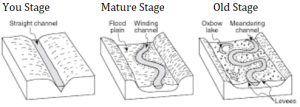A large portion of the rainwater is absorbed by the earth’s surface. Streams are created when excess water from rain, snowmelt, or near-surface groundwater accumulates on the ground surface and begins to run downhill. This excess water from rain or snowmelt generally occurs when the water accumulates at a faster rate than the soil and organic matter can absorb the water, plants can use it, or the water can be evaporated into the air.
Regardless of its water source, a stream follows the lowest places in the landscape, joining other tributaries from other low spots on the landscape. These small first-order and second-order streams may in turn join larger third-order streams, and so on, creating a dendritic drainage network within the watershed.
As the smaller streams join one another, the accumulated water’s quantity and velocity increase, and the water begins to cut into Earth’s surface, creating its own pathway. With time and differing flows, the stream modifies its pathway. This may cause problems for people who have assumed that the stream will keep to its original path. But the stream plays a balancing act among the volume of water it carries, the amount of sediment available, and the ground it must traverse.
Streams slowly change their characteristics over time in response to changes in elevation, gradient, volume of water, and available sediments. The development of the stream valleys takes place in an orderly fashion. There are three main stages of a stream. A valley passes through three stages during its evolution. The three stages are: (i) youth stage, (ii) nature stage, and (iii) old stage.

01. Youth Stage
A stream is said to be in the youth stage when it cuts its valley downward to establish a graded condition with its base level.
- Position. The youth stage is commonly found in mountainous regions from where a stream starts its journey.
- Erosion. Downcutting is dominant.
- Valley. Narrow V-shaped valley.
- Longitudinal Profile. The longitudinal profile is ungraded. The gradient is steep and the waterfalls and rapids are common.
- Valley Floor. The stream occupies most of the width of the valley floor as a result there is little or no flood plain.
- Stream Pattern. The stream course is angular and without meanders. Tributaries are short and few.
02. Mature Stage:
A stream is said to be in a mature stage when downward erosion diminishes and lateral erosion dominates.
- Position. The mature stage is found in the plains lying adjacent to the mountain region.
- Erosion. Downcutting is slight and side-cutting becomes dominant.
- Valley. Broad and trough-shaped.
- Longitudinal Profile. Waterfalls and rapid flows are absent. The Valley bottom is graded so that the longitudinal profile exhibits a relatively smooth curve. The gradient is moderate.
- Valley Floor. The stream swings in meanders. The flood plains are narrow and sandbars are present.
- Stream Pattern. The stream moves in meanders. The tributaries are many.
03. Old Stage:
In the old stage, the flood plain of a stream becomes several times wider than its meander belt.
- Position. The old stage is found near the mouth of streams.
- Erosion. In the old stage, the stream ceases to enlarge the flood plain. The main work of a stream is to rework the unconsolidated sediment of the flood plain.
- Valley. Valleys become wide and open with low boundaries which may be indistinct.
- Longitudinal Profile. The gradient becomes very low. The stream approaches the base level and it aggrades strongly.
- Valley Floor. Oxbow lakes are common. Natural levees are also present. Back swamps and yazoo tributaries accompany them. The meander belt is narrower than the valley floor.
- Stream Pattern. The stream pattern is meandering with oxbow lakes. The tributaries are few and large.
04. Rejuvenation Stage:
Tectonic uplift of a region or lowering of a base level may cause the stream gradient to be steepened and an old age or mature stream may be thus rejuvenated. The characteristic feature to look for is the presence entrenched meanders, which show that the stream once achieved a low gradient, but that the gradient has since been steepened, reinitiating downcutting. Increased rainfall due to climatic change may also initiate rejuvenation.
- Position. The old stage is found near the mouth of streams.
- Erosion. During the rejuvenated stage, erosion occurs when a river adjusts to a new base level after a disturbance, such as a sudden drop in sea level or land rise.
- Valley. A new, narrow floodplain is cut into an older, wider floodplain. The original valley floor is left above the new floodplain, forming steps on either side of the river.
- Longitudinal Profile. The gradient becomes high. It typically results from river rejuvenation with further rejuvenation able to form new terraces, resulting in a step like profile around a river.
- Valley Floor. The original valley floor is left above the new floodplain, forming steps on either side of the river.
- Stream Pattern. During the rejuvenated stage, rapid changes in stream discharge (caused by climate change) or sudden uplift of the land results in a “sudden drop of stream base-level. This results in the formation of entrenched meanders and the formation of stream terraces.
In the above discussion, it is assumed that the base level of a stream remains constant as a river progresses from the youth to the old stage. On many occasions, however, the land is uplifted. The effect of uplifting on a mature stream is to abandon lateral erosion and revert to downcutting. Such rivers are said to be “rejuvenated”. Mature streams readjust to uplift by cutting a new flood plain at a level below the old one. This produces step-like features in the river valley, which are called “river terraces”.
____________________________________________________________________________
- What are different types of streams?
- Introduction to Glaciers and types of glaciers
- Evolution of Geomorphological Thoughts
- Definition and Scope of Geomorphology